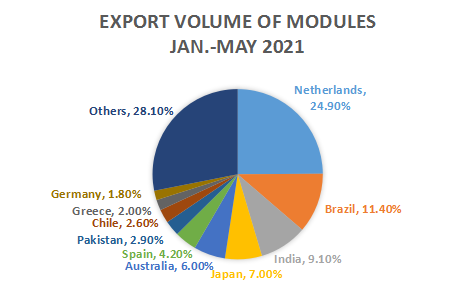In the first half of 2021, the production volume throughout the solar industrial chain in China has seen a strong rebound. The export of solar PV products witnessed a 35.6% growth despite the pandemic.
On July 22nd, the Symposium on Review of the Photovoltaic Industry in H1 2021 and Outlook of H2 2021 ” was held in Beijing. Wang Bohua, Honorary Chairman of the China Photovoltaic Industry Association (CPIA), summarized in his keynote speech the development of the PV industry in the first half of 2021 and predicted the industry’s future path.
Manufacturing
Wang said that the output of silicon wafers, cells and modules has increased significantly. The output of cells was 82.4GW, up 56.6% year on year, and that of modules reached 80.2GW, a year-on-year increase of 50.5%. This proves that the industry has quickly recovered from the impact of the pandemic.
The production of polysilicon was resilient amid the COVID-19 outbreak last year, but its output still saw a 16.1% increase to 238,000 tons in the first half of this year. Besides, the polysilicon production industry has seen the arrival of new players, with the largest planning capacity of up to 300,000 tons.
The market share of large-size wafers has also increased rapidly. The proportion of 182 mm and 210 mm wafers has reached 25%, up over 20% from last year.
The average conversion efficiency of cells has risen rapidly. The efficiency of mono PERC rose from 22.8% last year to 23%. The highest efficiency can be as high as 23.3% in leading enterprises. Meanwhile, the progress of n-type cells is accelerating. Gigawatt-level production capacity has already been deployed for TOPCon and HJT cells.
The power of modules have also quickly improved due to the promotion of large-size modules. The highest power can now reach 700W.
Export
From January to May, the export volume of solar PV products was about US$9.86 billion, with a year-on-year growth of 35.6%. Wang Bohua predicted that the number could reach 44GW to 46GW in the first half of the year.
According to the statistics of the CPIA, traditional markets such as Europe, Japan and Australia have maintained strong demand, while the demand of developing countries such as India, Brazil and Chile have become vibrant. As more solar markets emerge, the global solar market has become increasingly decentralized.

Source: CPIA
Bright prospect
The IEA and the IRENA both predicted that the proportion of renewable energy power generation will reach 90% by 2050. Wang commented that this figure was only 25% in 2018, so there is still massive room for growth. He also predicted that wind and solar PV will become major sources of renewable power.
The IRENA said in its World Energy Transitions Outlook report that, by 2050, the global PV installed capacity may exceed 14,000 GW. However, by the end of last year, the number was only 756 GW. The installed capacity needs to grow 400 GW on average per year to meet this goal.
As for the world’s newly installed capacity in 2021, the CPIA maintains its original judgment and predicts that it will reach 150 GW to 170 GW. By 2025, it will scale up to 270 GW to 330 GW.
The Chinese market accounts for a third of the world’s demand. The CPIA predicts an average annual growth of 70 GW to 90 GW from 2021 to 2025, and 55 GW to 65 GW is expected to be added this year. As only 14 GW was installed in the first half of the year, Wang hopes that the situation will turn around in the latter half of the year.



